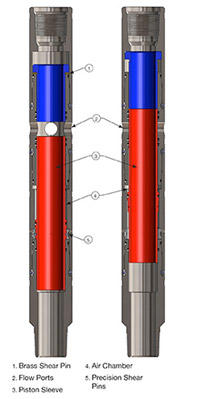Fill/Stop Fill Valve
Applications
- Partial cushion TCP perforating
- Permanent completions
- Drillstem Testing (DST)
Features
- Underbalance can be quantified before deploying gun system
- High precision shear pins guarantee actuation at required pressure
Benefits
- Tubing does not need to be filled joint by joint while running in hole
- Required underbalance will ensure proper perforation cleanup potentially improving productivity or injectivity
- No wireline or slickline tools required saving rig time
Fill/Stop Fill Valves are used to establish a predetermined fluid level in the tubing while running in hole or as circulating valves to displace well fluid prior to setting a plug or packer.
Partial cushions are commonly used for underbalance TCP perforating. Surging cleans the perforation tunnels which in turn reduces perforation skin and can potentially improve productivity or injectivity. The amount of fluid that can build up in the tubing (required hydrostatic pressure) is determined by the number of precision shear pins used. This will vary from job to job depending on well conditions.
The valve will remain open until the precision shear pins fail within ±5% of the calculated hydrostatic pressure. This causes the piston sleeve to move closing the valve. The valve will remain closed as long as there is hydrostatic pressure acting upon it.


